First things first, I gotta apologize for that dad joke of a title, but I just couldn’t help myself.
Look, if you’re a founder, product exec, or a product manager, you’re no stranger to the immense pressure of developing products that meet market demand, align with your company’s mission, and outperform competitors. And with customer needs and preferences constantly evolving, it can be challenging to decipher what really matters.
This is where the Jobs to Be Done Canvas (developed by the Jim Kalbach and the good folks at JTBD Toolkit) can come in handy as a simple north star. In this post, I’ll cover what the Jobs to Be Done Canvas is, how it can help you develop better products, and a step-by-step guide on how to use it.
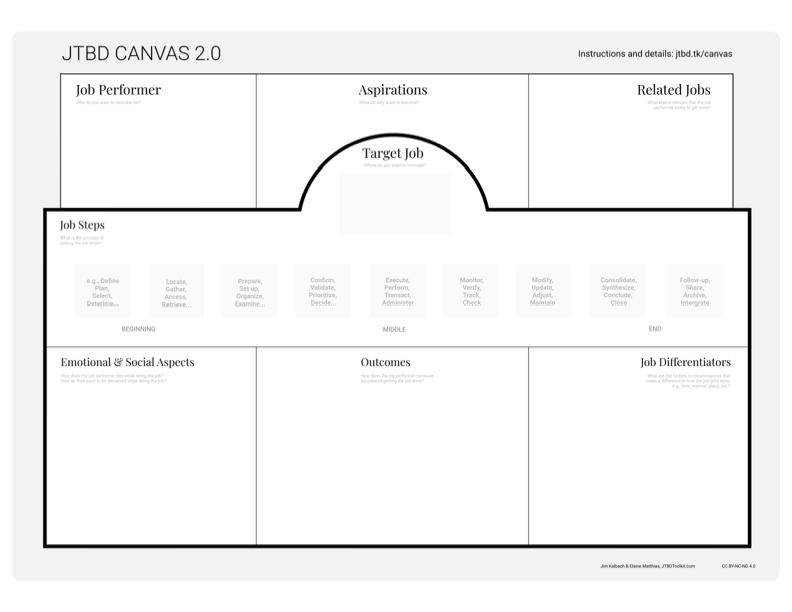
Understanding the Grand Design: Jobs to Be Done Theory
The JTBD theory, first proposed by Harvard professor Clayton M. Christensen, is a revolutionary take on customer needs. Instead of focusing on customer profiles or demographics, this theory focuses on the “job” that customers hire a product or service to accomplish.
JTBD takes you beyond demographics and superficial personas. It’s not about your customer’s age, job, or where they live. It’s about what they need to get done. It’s about understanding the task they’re trying to accomplish and how your product or service helps them do it.
A Job to Be Done:
- Is solution-agnostic.
- Results in progress when completed.
- Is relatively stable across time.
- A Job to Be Done doesn’t know what products or solutions have existed, currently exist, or might exist. It’s just framing some area of life where your customer is at the center of a struggle, and they want some help solving the problem .
If you’re brand new to JTBD, I’d recommend startinghereJobs to Be Done Framework and Its BenefitsUncover the hidden motivations that drive customer decisions with an innovative approach called Jobs To Be Done. Learn more about JTBD its benefits, and how it can revolutionize your product design for maximum impact.,hereHow to Write Jobs to Be Done Example StatementsLearn how to write effective Jobs to Be Done (JTBD) statements with examples and guidelines that will help you focus on customers’ core needs and integrate JTBD into your design process., andherePreparing for Success in Jobs to Be Done Interviews: Tips and TricksGet ready to conduct effective Jobs to Be Done interviews with our preparation guide, including understanding the Forces of Progress, coming prepared with notes, and learning from existing interviews. before digging much further into the JTBD Canvas.
Unlocking the Secret Door to Your Customers’ Minds with the JTBD Canvas
Kalbach’s version of the JTBD Canvas is a powerful tool in your JTBD toolkit.
In the startup world, canvases have become somewhat of a secret weapon for clear and organized thinking. Take the Lean Canvas or the Business Model Canvas, for instance. What makes these canvases so popular and useful? Simply put, they provide a visually intuitive, bird’s-eye view of complex concepts. They enable entrepreneurs and teams to map out, understand, and dissect significant parts of the problem in one place, whether it’s their business model, customer segments, or value proposition.
This visual approach not only facilitates a better high-level understanding of the challenges at hand but also encourages collaboration and active discussion within teams. It makes abstract ideas concrete, complex problems approachable, and provides a shared language for everyone involved.
Similarly, the JTBD Canvas aids in dissecting and understanding customers’ motivations and needs, helping innovation teams create more effective, user-centric solutions.
Diving Headfirst into the Top-Down Elements of the JTBD Canvas
The Job Performer: Your Customer Takes the Stage
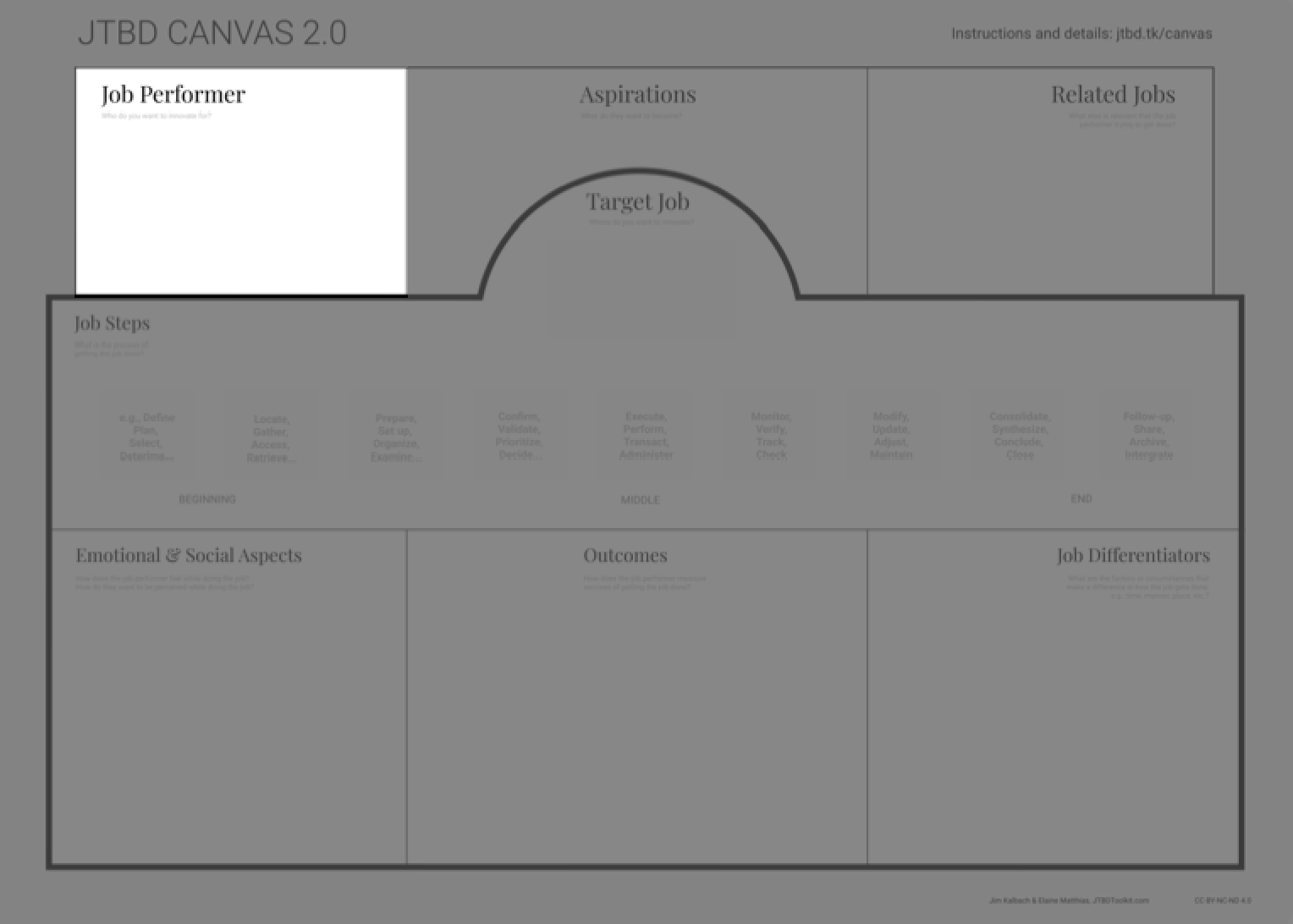
When setting out to create an exceptional product, your starting point should be the one who will be using it, the one who will ultimately decide if it’s a hit or a miss. That’s the Job Performer. In the JTBD world, this is your customer, the person you’re designing for.
Think of the Job Performer like the main character in a movie - their wants, their needs, their challenges are what drive the narrative forward. Your goal is to get into their shoes, understand their motivations, and what they’re trying to achieve. If your Job Performer is a busy parent, their goals might include streamlining the daily dinner prep chaos. If it’s a young professional, they could be seeking ways to maximize productivity in their day. Recognizing and understanding your Job Performer sets the stage for everything that follows.
Aspirations: A Glimpse into Your Customer’s Dreams
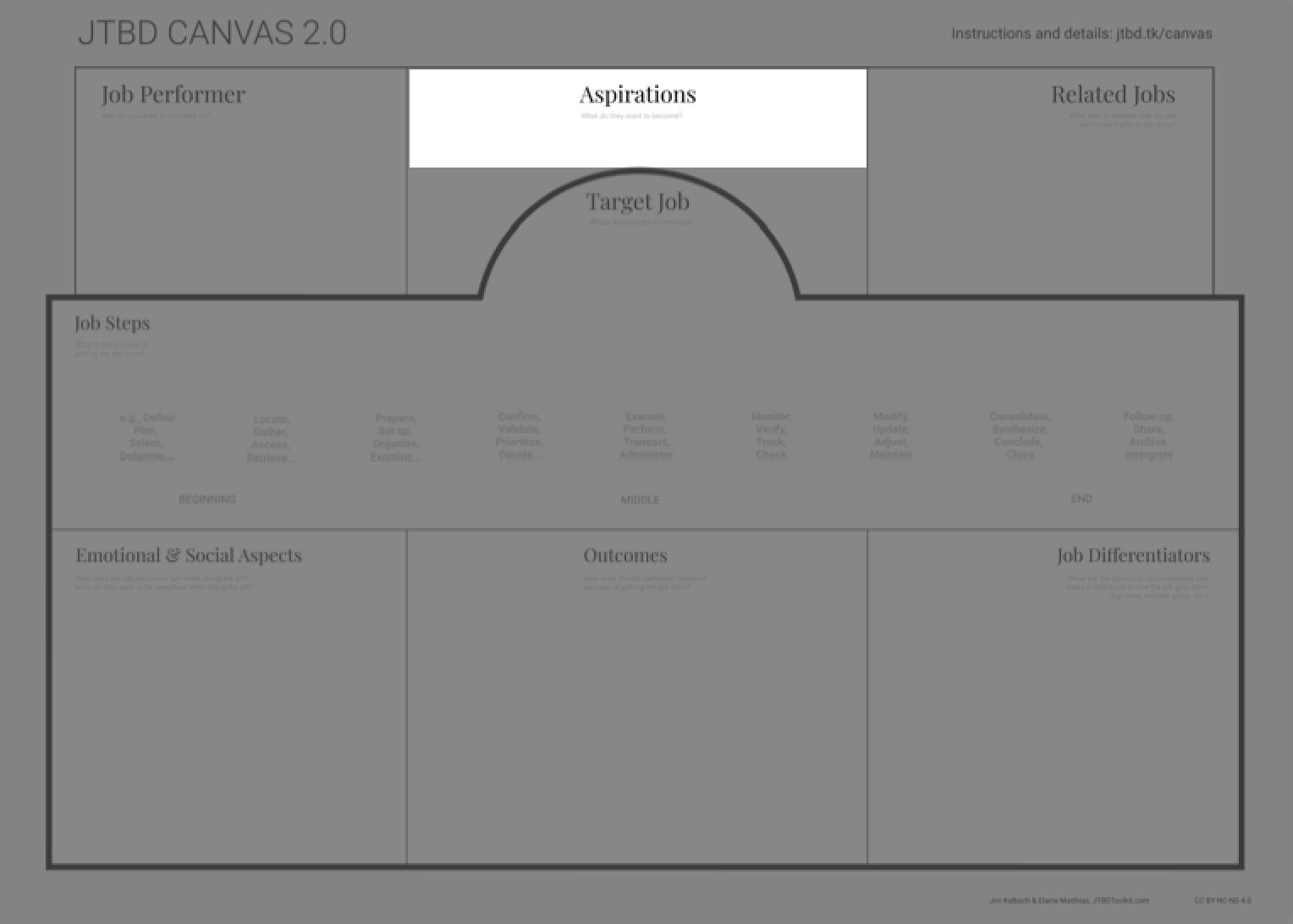
The hopes, dreams, and goals your Job Performer is aiming for by getting their job done; these are the aspirations we want to understand. This is the happy ending our main character strives for.
Let’s take the example of an amateur photographer. They’re not just snapping pictures randomly or fiddling with lighting settings out of curiosity. Their aspiration could be to capture that one breathtaking shot that’ll win them the local photography competition, or maybe even have their work showcased in a renowned photography magazine. By understanding the aspirations of your Job Performer, in this case, the amateur photographer, you can design a product or service that doesn’t merely assist in taking photos, but actually propels them towards their dreams - turning their artistic vision into a stunning reality.
Understanding a customer’s aspirations is key to understanding their motivations and desired outcomes. The following questions can help uncover these aspirations during aJobs to Be Done interviewPreparing for Success in Jobs to Be Done Interviews: Tips and TricksGet ready to conduct effective Jobs to Be Done interviews with our preparation guide, including understanding the Forces of Progress, coming prepared with notes, and learning from existing interviews.:
- What is your ultimate goal in using a product/service like ours?
- How do you see our product/service helping you in achieving your goals?
- What does success look like to you when using our product/service?
- Can you describe a situation where our product/service would have significantly improved your day/life/work?
- What are some of the things you wish you could do but currently cannot, or find difficult, in relation to our product/service?
- How would you like to see your life/work change in the future in relation to our product/service?
- How would using our product/service more effectively contribute to your long-term goals?
- Can you think of a moment when you felt very successful or fulfilled in relation to our product/service? Can you describe that moment?
These questions are designed to dig deep into the customer’s aspirations. Remember, the more detailed and personal the answers, the more you’ll understand about what drives them and what they aspire to achieve, helping you align your product or service accordingly.
The Target Job: Focusing on the Perfect Shot
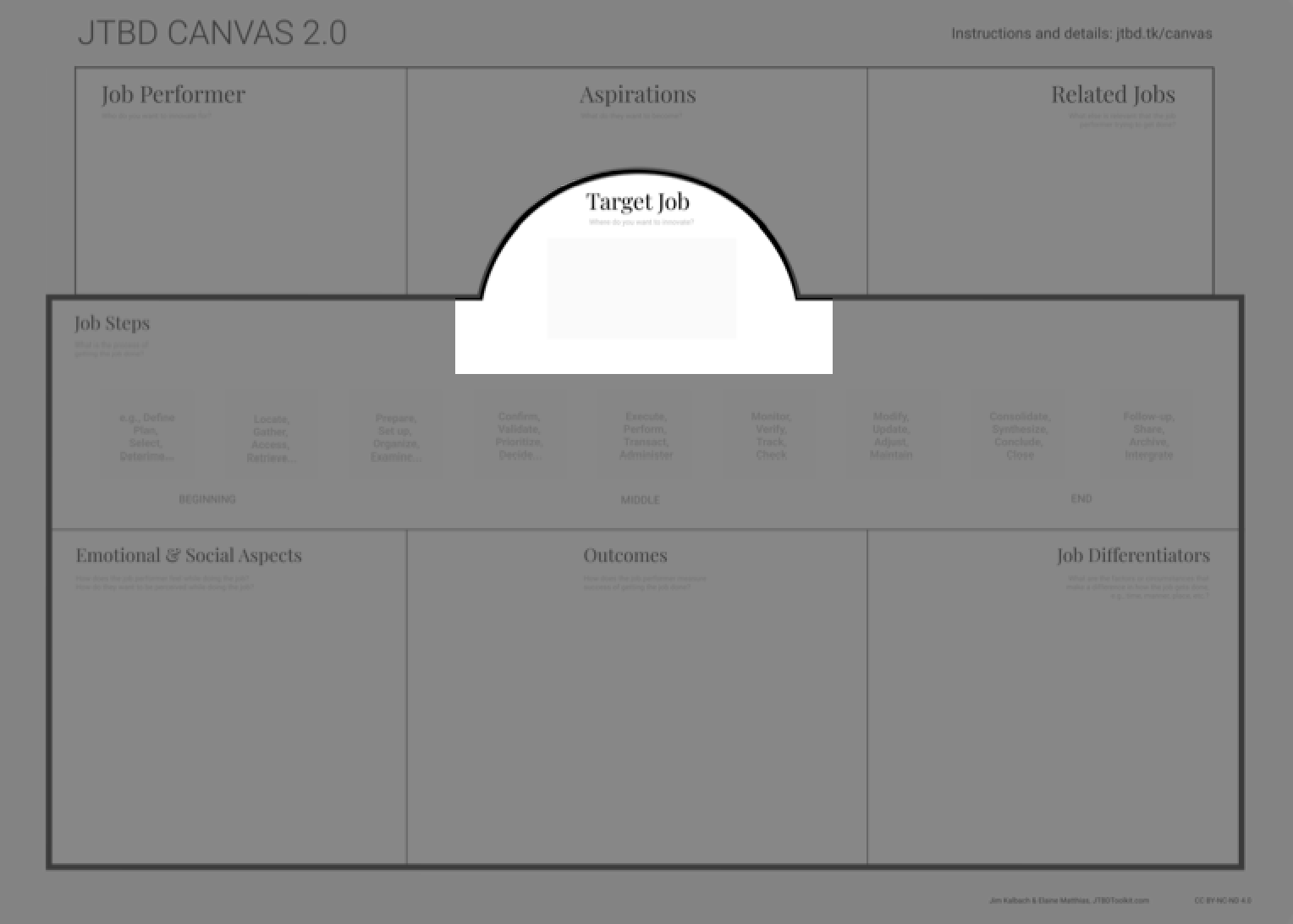
Now, let’s think about the amateur photographer for a second. The primary goal or the “target job” isn’t just to take pictures, right?
The target job is this core task they’re trying to achieve, the crux of their photographic endeavors, and the focal point of the JTBD Canvas.
It’s that main task your customer is trying to accomplish, the reason they pick up your product in the first place. It’s the job they hire your product to do, to echo the words of Clayton Christensen. When you’ve identified this target job, you have a clear line of sight into what your product must accomplish to satisfy your customers.
For instance, if our amateur photographer’s target job is to “Capture high-quality images for their travel blog,” they’ll need a camera that delivers sharp, high-resolution images and maybe even has integrated capabilities for easy sharing or posting. Understanding this target job allows a camera manufacturer to design features and functions that directly aid in accomplishing this task, such as a high-quality sensor for better image resolution or inbuilt Wi-Fi for easy image transfer.
This is the power of understanding the target job - it allows you to create products that hit the mark, satisfying your customers by solving their precise problem and performing their target job exceptionally well.
The opening chapter of Jim Kalbach’s book, The Jobs To Be Done Playbook is a spectacular resource for mastering the art ofwriting a well-defined JTBDHow to Write Jobs to Be Done Example StatementsLearn how to write effective Jobs to Be Done (JTBD) statements with examples and guidelines that will help you focus on customers’ core needs and integrate JTBD into your design process..
The Supporting Cast: Focusing on the Bigger Picture with Related Jobs
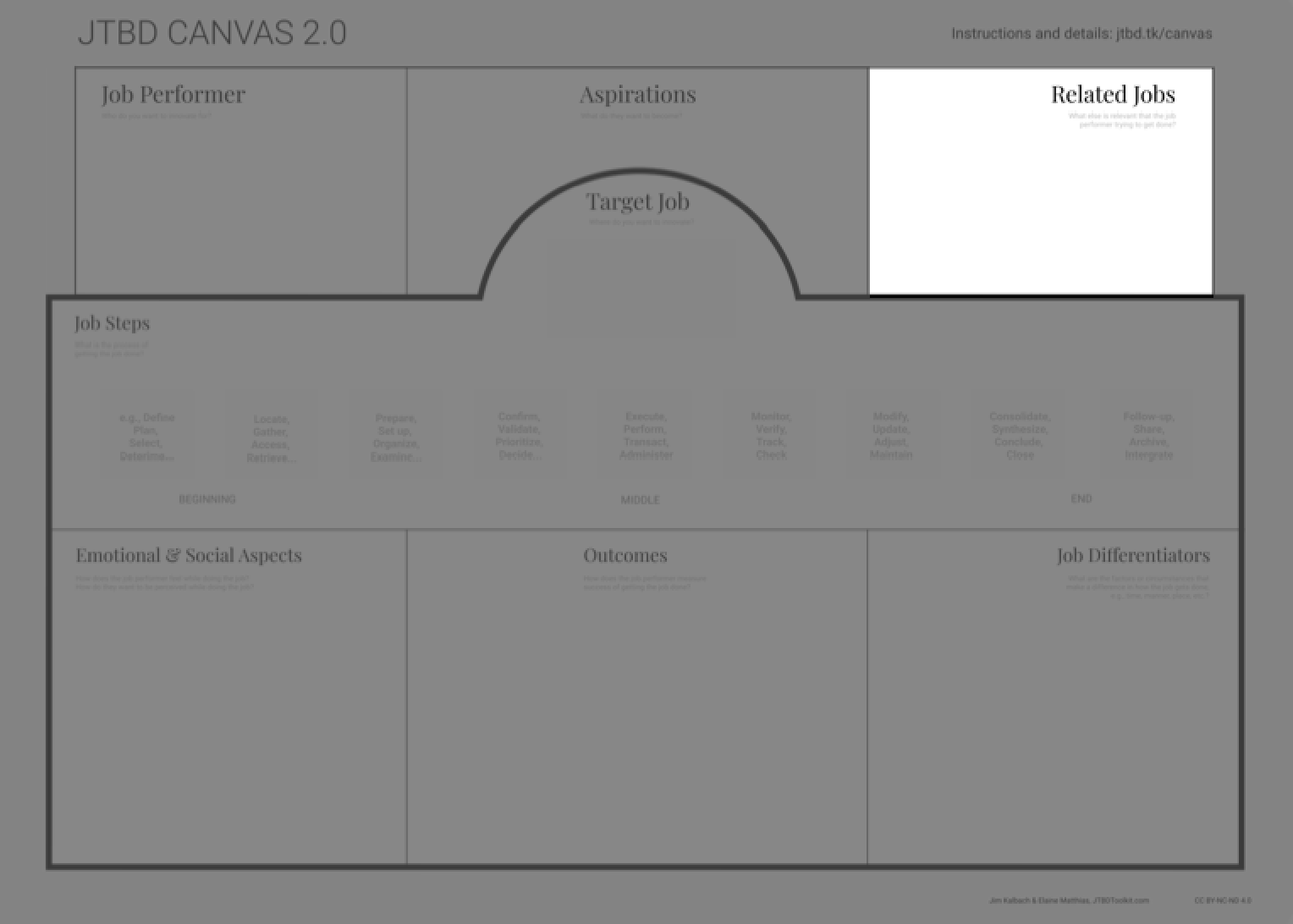
Just like in a well-directed film, where each supporting character plays a pivotal role in enriching the storyline, related jobs add context and depth to your understanding of the customer’s journey. They provide a more holistic view of what your customer is trying to achieve and the obstacles they might face along the way.
Let’s go back to our amateur photographer. Yes, their target job is capturing high-quality images for their travel blog, but that’s not the whole story. There are numerous related jobs that go hand in hand with this target job. They might need to edit their photos for the perfect aesthetic, upload them to their blog, or back them up safely. Maybe they want to learn more about different photography techniques or even network with other photographers for ideas and inspiration. These are all examples of related jobs.
By identifying these related jobs, you get a full panoramic view of your customer’s journey, rather than a narrow snapshot. This allows you to find new opportunities to add value and potentially expand your product’s feature set. Using our example, a camera manufacturer might consider building in editing software, offering cloud storage for backing up photos, or creating a platform for photographers to share their work and learn from each other.
Remember, by satisfying the related jobs, you can create a product experience that not only accomplishes the target job but also enhances the overall journey your customer takes, cementing your product as an invaluable tool in their toolkit.
Unearthing related jobs involves a deeper dive into the customer’s journey. Here are some questions you could ask of the amateur photographer to find the related jobs. You can imagine how you might rephrase them depending upon the product or service you’re researching.
- “Can you walk me through your process after you capture an image?”
- “What activities or tasks are associated with your photography process?”
- “Do you use any other tools or software alongside your camera?”
- “What do you do once you’re satisfied with the quality of your images?”
- “What other tasks would you like your camera to perform?”
- “Are there other tasks related to your photography that you find challenging or time-consuming?”
- “Do you participate in any forums, communities, or events related to photography?”
- “What activities do you perform to improve your photography skills?”
These questions help unveil what your customer does before, during, and after completing their target job, allowing you to see a more complete picture of their journey and potentially uncover new opportunities to assist them.
The Journey: Job Steps

To truly understand our customers, we need to walk in their shoes, one step at a time. It’s not just about what they’re doing, but how they’re doing it. The JTBD Canvas incorporates the Job Map as popularized by Tony Ulwick and by allowing for some exploration into this “Jobs as activities” portion of the research, you give yourself an opportunity to zoom way in on your customers’ context.
Once again, exploring this concept using the example of the amateur photographer, I’ll describe these eight steps to give you a sense for what you’ll be looking for as you conductJTBD interviewsPreparing for Success in Jobs to Be Done Interviews: Tips and TricksGet ready to conduct effective Jobs to Be Done interviews with our preparation guide, including understanding the Forces of Progress, coming prepared with notes, and learning from existing interviews. with your customer base to fill out your JTBD Canvas.
-
Define: This is the conception stage. Our amateur photographer determines what they want to capture. Is it a sweeping landscape, a candid street scene, or a meticulously arranged still life? They set their intention for the task at hand.
-
Locate: Now that they’ve defined their task, our photographer needs to find the right environment or subject. They may scout locations, wait for the right light, or hunt for that perfectly photogenic moment.
-
Prepare: With their subject in sight, it’s time for our photographer to prepare. They adjust their camera settings, manipulate their environment (perhaps adding lighting or props), and compose their shot.
-
Confirm: Before pressing the shutter, they confirm everything is as it should be. Is the lighting right? Is the composition pleasing? Are the settings appropriate for the scene? They might take a few test shots to ensure everything’s perfect.
-
Execute: It’s time to capture the image. They steady their hand, hold their breath, and press the shutter release. Click. The moment is captured.
-
Monitor: After taking the shot, our photographer checks their work. They review the image on their camera’s screen, zooming in to check for sharpness, exposure, and overall quality.
-
Modify: If the image doesn’t meet their expectations, they’ll adjust and reshoot. This could involve tweaking camera settings, altering the light, or even waiting for a more opportune moment.
-
Complete: Finally, satisfied with their captured image, they pack up their gear. The job’s done - at least until they get home to edit and share their masterpiece.
By breaking down the target job into its constituent steps, the JTBD Canvas gives us a roadmap of our customer’s journey. We see where the road is smooth and where it gets bumpy, allowing us to innovate and create a product experience that turns obstacles into open highways.
Emotional & Social Aspects: The “Why” Behind the Job

An important component of the JTBD Canvas you won’t want to discount are the emotional and social facets of a job. While our photographer’s task appears straightforward, it’s infused with emotions and social implications that shape their experience.
Emotional Aspects: The Inner Landscape
Now, let’s explore the emotional terrain. These are the feelings that our amateur photographer experiences or aims to avoid during each step of their job.
For instance, during the Define stage, they might feel a sense of excitement and anticipation as they imagine capturing the perfect shot. When they Locate and Prepare, this might give way to a sense of determination and focus. However, if they struggle to find the right subject or can’t get their settings just right, frustration may creep in.
When it’s time to Execute, there might be a moment of exhilaration as they capture their vision, followed by the satisfaction (or disappointment) they feel when they Monitor the results. Lastly, the sense of accomplishment when they Complete the job, or the relief of finally capturing that elusive shot.
By understanding these emotional touchpoints, we can design our products to enhance positive feelings (like satisfaction and accomplishment) and alleviate negative ones (like frustration or disappointment).
Social Aspects: The Group Picture
Now let’s step back and look at the group picture - the social aspects. These are the ways our amateur photographer wants to be seen by others (or avoid being seen) while performing their job.
Perhaps our photographer prides themselves on their independence and wants to be seen as a self-sufficient creative, mastering their craft without assistance. Maybe they desire recognition from their peers and hope to be seen as a skilled and dedicated artist. Conversely, they might fear being perceived as a novice or a “fake” photographer and want to avoid this stigma.
These social aspects can be powerful drivers (or deterrents) in the job our customer is trying to get done. If we can create a product that helps our customers feel competent and respected in their community, we’re not just helping them get a job done - we’re helping them feel seen, understood, and appreciated.
Peeling back the layers of emotional and social aspects can reveal deep-seated needs and desires that aren’t immediately apparent but have a significant impact on our customer’s experience. It’s these hidden insights that can be the key to creating truly customer-centric products.
Desired Outcomes: How the Customer Measures Success
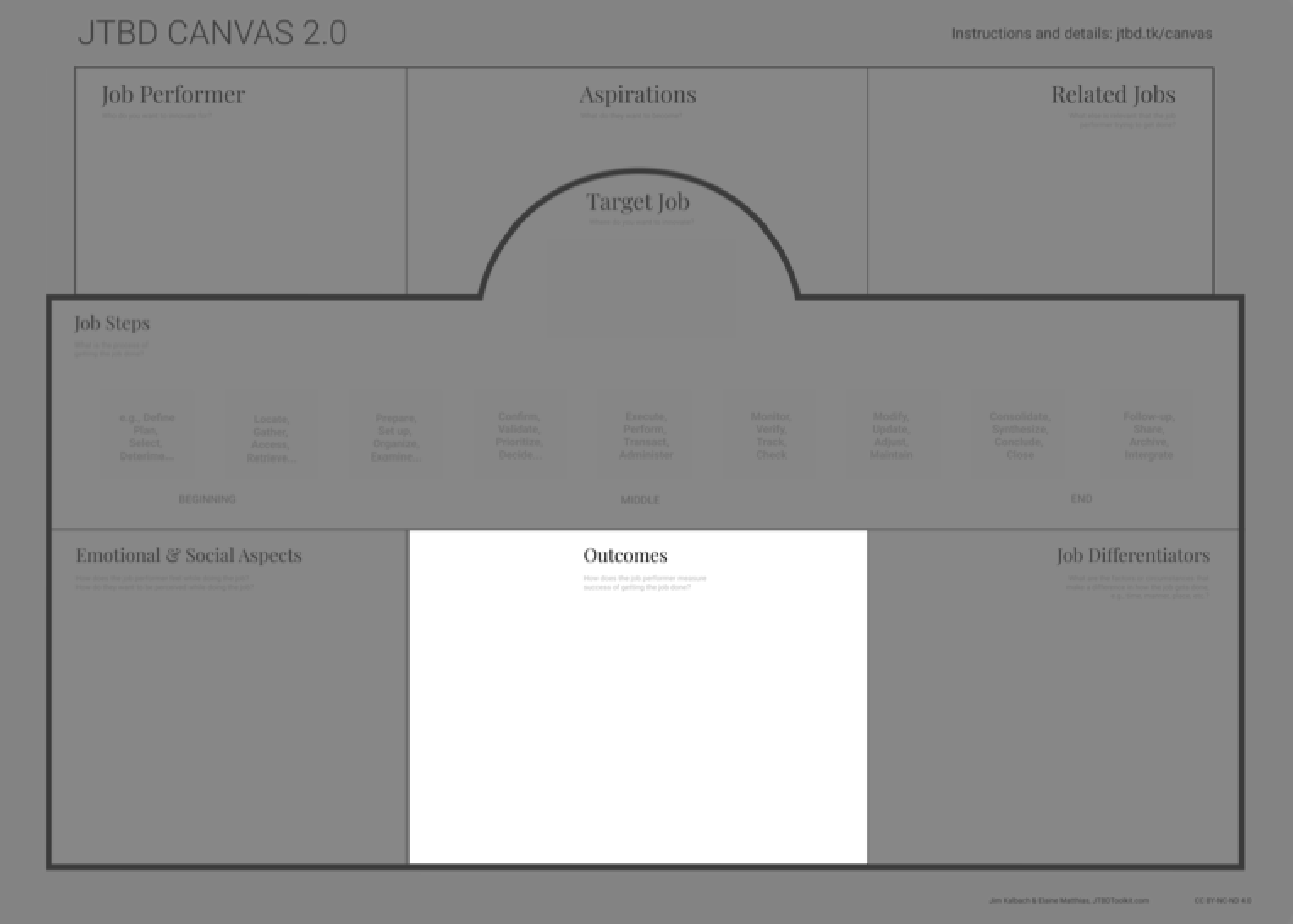
Outcomes are like the scorecard for the Job Performer - they’re the way our amateur photographer evaluates whether or not they’ve successfully executed their target job. It’s important to remember that outcomes can be wildly diverse because they are inherently subjective and directly tied to the individual’s personal perception of success.
The Ingredients of an Outcome
Generally, an outcome statement is composed of three primary components:
A verb indicating a direction of change: This usually involves minimizing or increasing something. It denotes a desire to alter the status quo.
A unit of measure: Typically, this takes the form of time, effort, money, probability, or frequency. It provides a benchmark against which progress can be evaluated.
Qualifiers: These provide specific contexts or conditions that make the outcome statement relevant to the target job.
Now let’s take these elements and apply them to our amateur photographer.
Deciphering Outcomes: The Photographer’s Perspective
Our amateur photographer may have a multitude of potential outcome statements, depending on their specific goals and priorities. For example, they might want to:
“Minimize the time it takes to set up a shot.” Here, the direction of change is minimizing, the unit of measure is time, and the qualifier is “setting up a shot.”
“Increase the likelihood of high-quality photos taken during a shoot.” In this case, the desired change is an increase, the measure is the number of photos, and the qualifier is “high-quality photos during a shoot.”
“Minimize the likelihood of equipment malfunction during a shoot.” Here, the goal is to reduce, the unit is the likelihood, and the qualifier is “equipment malfunction during a shoot.”
When designing products or services, it’s crucial to bear these outcomes in mind. By focusing on facilitating these outcomes, you can create solutions that truly resonate with your customers, meeting not just their functional needs but their deeper aspirations and desires as well.
This is the magic of the Jobs-To-Be-Done theory. It’s not just about understanding what your customers are doing; it’s about understanding why they’re doing it, how they measure their success, and ultimately, how you can help them do it better.
Unlocking Innovation with the JTBD Canvas
As our exploration of the JTBD Canvas draws to a close, it’s clear that this framework is far more than just a collection of boxes and lines. It’s a blueprint for understanding, a roadmap to innovation, and a secret key to your customers’ minds. Like the trusty allen key in an IKEA flat pack, it’s the simple tool that makes everything fit together.
JTBD and the Canvas work hand in hand to enable a deep understanding of your customers’ needs, wants, aspirations, and related jobs. It’s about more than just creating a product; it’s about designing experiences, building relationships, and empowering your customers to achieve their dreams.
By adopting the JTBD approach and incorporating the Canvas into your innovation process, you’re not only setting yourself up for product success but also aligning your strategies with your customers’ goals. It’s about bridging the gap between what your product does and what your customers want it to do.
So why not give it a try? Implement the JTBD Canvas in your next product design session. See how it shifts your perspective and opens up new avenues of innovation. And remember, the beauty of this tool lies not just in its application but also in the conversations it ignites, the ideas it sparks, and the understanding it fosters.
Finally, we’d love to hear about your experiences with the JTBD Canvas. What new insights did it offer? How did it influence your innovation and design process? Your stories are just as important to the conversation as the theory itself. After all, we’re all just trying to get a job done - and together, we can make that job easier, more successful, and more enjoyable.
As you venture into the world of Jobs-To-Be-Done, remember: every customer has a job to be done, and with the JTBD Canvas in hand, you’re perfectly equipped to help them get it done. Here’s to your journey and the innovation it will undoubtedly spark. Happy travels!

